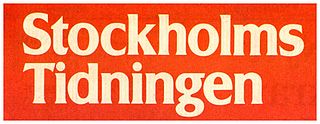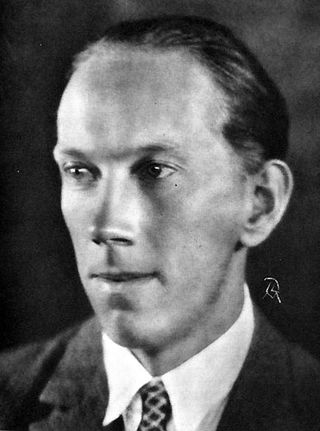Related Research Articles

August Teodor Palm was a Swedish socialist activist and a key person in introducing the then revolutionary social democratic labour movement in Sweden.

Karl Hjalmar Branting was a Swedish politician who was the leader of the Swedish Social Democratic Party (SAP) from 1907 until his death in 1925, and three times Prime Minister of Sweden. When Branting came to power in 1920, he was the first Social Democratic Prime Minister of Sweden. When taking office for a second term after the general election of 1921, he became the first democratic socialist head of government in Western Europe elected under universal suffrage. An early supporter of modern social democracy and democratic socialism, he led the SAP through a transformation from a radical socialist movement to Sweden's dominant party; the Social Democrats have been Sweden's largest party in every election since 1914, and formed government for 44 continuous years from 1932 to 1976.

Expressen is one of two nationwide evening newspapers in Sweden. Describing itself as independent liberal, Expressen was founded in 1944; its symbol is a wasp and its slogans are "it stings" or "Expressen to your rescue".
Dala-Demokraten is a Swedish social democratic newspaper published in Falun, Dalarna, Sweden. It has been in circulation since 1917.

Axel Danielsson was a Swedish socialist agitator, journalist and writer. He was a prominent leader of the early Swedish Social Democratic Party. Danielsson retranslated Karl Marx's The Communist Manifesto into Swedish in 1886.

Anarchism in Sweden first grew out of the nascent social democratic movement during the later 19th century, with a specifically libertarian socialist tendency emerging from a split in the movement. As with the movements in Germany and the Netherlands, Swedish anarchism had a strong syndicalist tendency, which culminated in the establishment of the Central Organisation of the Workers of Sweden (SAC) following an aborted general strike. The modern movement emerged during the late 20th century, growing within a number of countercultural movements before the revival of anarcho-syndicalism during the 1990s.
Arbeideren was a Norwegian newspaper, published in Hamar, Hedmark county. It was started in 1909 as the press organ of the Labour Party in Hedemarken and its adjoining regions, and was called Demokraten until 1923. It was issued three days a week between 1909 and 1913, six days a week in 1914, three days a week again between 1914 and 1918 before again increasing to six days a week. It was renamed to Arbeideren in 1923, and in the same year it was taken over by the Norwegian Communist Party. The Communist Party incorporated the newspaper Gudbrandsdalens Arbeiderblad into Arbeideren in 1924, and until 1929 the newspaper was published under the name Arbeideren og Gudbrandsdalens Arbeiderblad. After Arbeideren had gone defunct, the name was used by the Communist Party for other newspapers elsewhere.

Christian Holtermann Knudsen was a Norwegian typographer, newspaper editor, publisher, trade unionist and politician for the Norwegian Labour Party. He is known as chairman of his party in three non-consecutive periods, and also founded what would become the main party newspaper. He served three terms in the Norwegian Parliament.

Carl Jeppesen was a Danish-born Norwegian worker, newspaper editor and politician. He edited the newspaper Social-Demokraten from 1887 to 1892, and from 1906 to 1912. He was among the founders of the Norwegian Labour Party, and served as chairman for two periods, from 1890 to 1892, and from 1894 to 1897. He was Mayor of Kristiania from 1917 to 1919.

Under röd flagg was a weekly magazine published in Sweden in 1891 by Hinke Bergegren. Bergegren acted as the editor and publisher of the magazine. Nine issues were published from March to June 1891. Under röd flagg sought to bring together writers from the political peripheries of the Social-Democratic Party. Articles in the publication contained Marxist, anarchist and anarchist communist ideas. Under röd flagg was the first periodical to introduce a detailed account of anarchist thought in Sweden, for example through texts of Peter Kropotkin, Leo Tolstoy, Élisée Reclus and Swedish anarchists.
Stockholms Dagblad was a conservative morning newspaper published in Stockholm between 1824 and 1931.

Stockholms-Tidningen was a Swedish-language morning newspaper published in Stockholm, Sweden, between 1889 and 1984 with an interruption from 1966 to 1981. It was one of the major dailies in the country together with Dagens Nyheter and Aftonbladet in the 1960s.
Arbetet was a Swedish-language social democrat newspaper published in Malmö, Sweden, between 1887 and 2000.

Axel Teodor Danielson, was a Swedish editor-in-chief.

Elma Danielsson née Sundquist, was a Swedish journalist and politician. She was a journalist and temporary editor of the social democratic paper Arbetet from 1887 onward, and has been referred to as the first woman in the social democratic press.

Erik Axel Blomberg was a Swedish poet, translator and critic.
Social-Demokraten was a Swedish newspaper published from 1885 to 1944.
Lisa Mattson (1918-1997) was a Swedish politician.
Folkviljan was a newspaper published in Malmö, Sweden, between 1882 and 1883. It is known as the first social democratic publication in Sweden. It is also known for its founder and editor August Palm.
References
- 1 2 3 4 Irene Scobbie, ed. (2006). Historical Dictionary of Sweden (Second ed.). Lanham, MD: The Scarecrow Press, Inc. p. 193. ISBN 978-0810853751.
- 1 2 Henrik Åström Elmersjö (2017). "Establishing an Ideologically Coherent History". Scandinavian Journal of History . 42 (2): 197–198. doi:10.1080/03468755.2016.1261445. S2CID 151762128.
- 1 2 "Morgon-tidningen Social-demokraten". Library of Congress . Retrieved 7 March 2022.